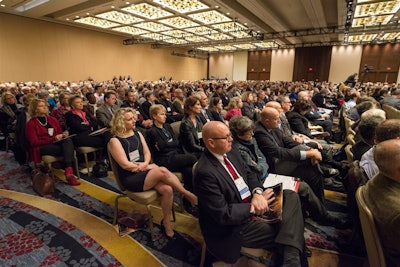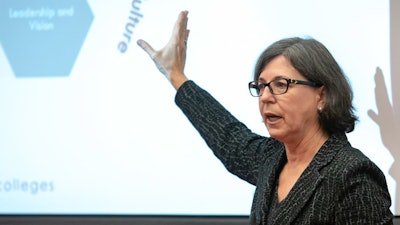 A past annual conference hosted by the American Association of Colleges and Universities (AAC&U)
A past annual conference hosted by the American Association of Colleges and Universities (AAC&U)
“We had planned a hybrid meeting from the beginning—not to say we anticipated Omicron, but we saw the opportunity over the past year and a half for greater and more diverse participation in virtual conferences,” said Dr. Dawn Michele Whitehead, vice president of the office of global citizenship for campus, community and careers at the American Association of Colleges and Universities (AAC&U), a global membership organization that centers on undergraduate liberal education.
This Wednesday, AAC&U will start a four-day annual meeting after choosing last fall to offer an in-person and virtual component. In-person attendees will join events in Washington, D.C, and will be required to show proof of vaccination and wear masks indoors. Plenary sessions and some concurrent sessions will be live-streamed for both virtual and in-person registrants. All conference participants will be able to watch session recordings after the conference.
“I think people waited a little later than usual to register for the conference, especially those with an in-person dimension, because people were watching to see what was going to happen,” said Whitehead. “As people had a better sense of what was going on, we saw more people make a decision on virtual or in-person attendance.”
Whitehead noted that AAC&U has also been allowing members to switch from in-person to virtual at the last minute. In-person attendees at the conference can additionally access the virtual platform if they decide not to join sessions or if they report COVID-19 symptoms and can no longer be present in-person.
“This week, I have heard some people say things like, ‘I have a young child, they’re not vaccinated, so I’m not comfortable with attending in-person,’” said Whitehead. “So, we have seen people take advantage of those changes so that they can still participate.”
But not all associations have the resources to offer a hybrid conference.
About two weeks ago, the Council of Independent Colleges (CIC), a membership association dedicated to nonprofit independent colleges and universities, brought together the presidents of independent colleges and universities from January 4 to 7 in Marco Island, Florida. At this annual conference called the Presidents Institute, attendees were required to be vaccinated with proof of vaccination.
“We knew early on that we didn’t have the staff to do a hybrid experience well,” said Dr. Marjorie Hass, president of CIC, on the choice to go in-person. “Then as Omicron spiked, we needed to review our plans, so we talked with medical advisors and with our board to come to a decision that we would be all in.”
CIC decided to have an on-site medical clinic with COVID-19 testing. The warm weather of Florida would allow attendees to safely gather outside for meals as well. They offered a lenient cancellation policy in addition given Omicron’s quickly changing status. Attendance was down about 20% this year, though Hass said that “was better than I expected.”
Out of around 700 attendees, at least two reported COVID-19 symptoms at the conference, according to Hass. She noted that participants gave mostly positive feedback after the event. Several organizations have been in touch with CIC seeking advice as they plan in-person conferences of their own.
“If you’re really going to be all-in and in-person, you have to have the confidence that your attendees will buy into your safety program,” said Hass on the advice she has shared. “If you have a sense that there will be grudging adherence to the safety program, that won’t do it for you. We knew we’d have attendees who would abide by the spirit and letter of the health plan. That confidence in our group let us go ahead with it.”
Dr. Karen A. Stout, president and CEO of Achieving the Dream (ATD), a professional membership and advocacy organization dedicated to community colleges, similarly emphasized that there is no one-size-fits-all approach as each organization weighs such conference planning choices.  Dr. Karen A. Stout
Dr. Karen A. Stout
“All of us have varying audiences and different considerations,” said Stout. “So, I want to say that first because these decisions are difficult for every one of us to make.”
From February 14 to 17, ATD’s annual conference called DREAM will be fully virtual. ADT made the decision to go virtual months before Omicron came on the scene. After its virtual conference last year, ATD asked college presidents and their ATD teams what they were comfortable with for the following year. Largely due to the Delta variant’s surge at that time, several of DREAM’s key audiences voiced worries over an in-person gathering.
“We found that faculty and student affairs professionals were more concerned about travel than maybe other groups,” said Stout of the feedback they received. “Plus, there were a number of institutions or states that had COVID-19 travel guidance policies, which would then mean not all institutions would have the same access. Being an equity organization, that also concerned us.”
Similar to CIC, Stout added that ATD did not have the capacity to do both a virtual and in-person conference “in an exemplary way.” Without hybrid as an option, she said that one central point swayed the call to go virtual.
“What it came down to is that we simply did not want to ask the faculty and student affairs professionals who have been so essential in this student success work, people who themselves are parents and partners and colleagues, to take a health risk for a conference, no matter how special we believe DREAM is,” said Stout. “In turn, we also knew that if we were asking them to travel, we were also asking them to leave their students at a key time when students would sill have so much disruption in the pandemic.”
Like Whitehead at AAC&U, Stout noted that a virtual conference additionally would allow ATD to reach more people who may not have been able to attend in-person, in part due to the cost of travel. Some colleges told ATD that they prefer virtual because they can give more people on their campuses access to DREAM.
But Stout said that she still looks forward to an in-person annual meeting, hopefully in 2023.
“I’ll definitely tell you: I don’t know how sustainable a virtual-only meeting will be for us in the future,” she said. “Most of the peer learning that happens for us will be spontaneous in meetings, and it’s hard to replicate that in a virtual space.”
That difficulty of replicating community in a virtual arena was a big reason why the American Council of Education (ACE), the nation’s largest higher education membership organization, decided to hold its 2022 annual meeting in-person from March 5 to 7 in San Diego, California. Attendees will be required to provide proof of vaccination and wear masks indoors.
"We committed to being in-person last year when we really saw how much of a hunger there was to do some of the networking and relationship-building that comes with bringing people together," said Mushtaq Gunja, senior vice president and chief of staff at ACE. "I feel like people are so tired of Zoom. But we also wanted to be safe, so we made the decision early on to mandate vaccines."
After a virtual conference last year, ACE surveyed participants and consistently heard requests for a safe, in-person gathering for the following year. ACE weighed offering a hybrid conference, yet Gunja said that the organization was concerned that they would not be able to pull it off well enough.
"There are organizations that have been able to pull off amazing hybrid meetings, and I am in awe," said Gunja. "But I think we were worried about making sure that everyone had the experience that they wanted after what we saw in our survey."
Looking ahead, Gunja noted the meeting's location in San Diego means that the conference will not only be working under some of the strictest state regulations for COVID-19 but will also be in warmer weather for people to gather outdoors. The timing in March additionally seems hopeful. Gunja said current data suggests many states by then may be past the peak of Omicron cases.
"But we're watching it closely," he added.
Similar to ACE, the American Association of Community Colleges (AACC), an advocacy organization for community colleges, will host an in-person annual meeting from April 30 to May 3 in New York City.
“I can’t really overstate the importance of getting to connect with each other in person,” said Dr. Martha Parham, senior vice president of public relations at AACC. “Especially for community colleges, where we’ve been seeing enrollment declines and so many challenges in this pandemic. Everyone has been dealing with this in isolation. Coming to this meeting to be with someone going through the same issues that you are going through could build solidarity.”
AACC will follow state and federal regulations regarding COVID-19. As New York City has some of the strictest regulations in the country, Parham added that she is hopeful attendees will be able to safely come together.
Still months away, November 2022 will mark the annual meeting for the Association for the Study of Higher Education (ASHE), a scholarly society of higher education researchers. The conference is scheduled for now to be hybrid with the in-person component taking place in Las Vegas, Nevada. Similar to fellow higher education organizations, ASHE will adhere to the state and federal COVID-19 safety guidelines for gatherings. Last November, the organization held a successful gathering in San Juan, Puerto Rico.
“Like last year, we’ll have to see what things look like as we get closer to November,” said Dr. Jason Guilbeau, executive director of ASHE, on whether the annual meeting will pivot to fully virtual. “As we move forward, knowing that an in-person conference can provide community and build networks while a virtual component can improve access, our question is how we balance the two. A lot of people are probably having that long-term strategy discussion.”
To Whitehead, navigating conference planning with Omicron has only reaffirmed a sense of community in higher education: “If we’ve learned anything in the pandemic, it's that we have to be flexible and patient with each other as things change.”
Rebecca Kelliher can be reached at [email protected].
















